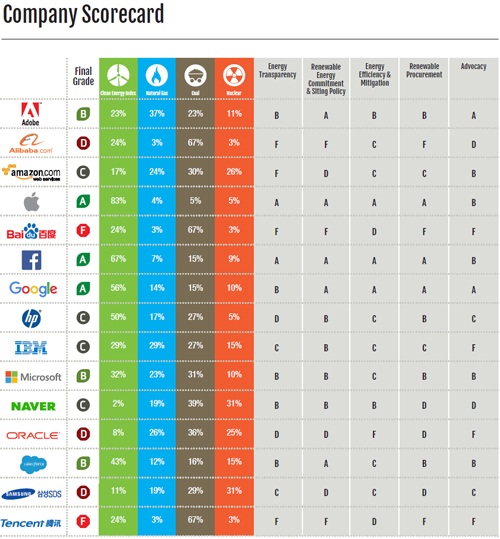News
AWS Earns 'C' Grade in Green Computing Report
A report released Tuesday by environmental watchdog group Greenpeace once again puts Amazon Web Services (AWS) on the hot seat for not being more forthcoming about its cloud infrastructure's energy footprint.
The report, titled "Clicking Clean: Who Is Winning the Race to Build a Green Internet?" assesses major tech companies -- including cloud services providers like AWS, Microsoft, Oracle, Google, IBM, Salesforce.com and Rackspace -- based on their level of "clean energy" usage. Greenpeace evaluated companies on their mix of renewable-energy sources; transparency; renewable-energy commitment and policies; energy efficiency and greenhouse-gas mitigation; renewable-energy procurement; and advocacy.
The group gave public cloud leader AWS an overall "C" grade, putting it behind infrastructure rivals Google (which earned an "A") and Microsoft ("B"). See the table below for the full list of companies surveyed and their scores.
 [Click on image for larger view.] Source: Greenpeace
[Click on image for larger view.] Source: Greenpeace
Greenpeace credited AWS for its advances toward greener computing in recent years, including its 2014 pledge to eventually run its entire infrastructure on renewable energy, as well as its plans to launch multiple wind and solar farms across the United States. However, as it has done in previous years, it gave AWS a failing grade for its transparency -- or lack thereof.
"One of the single biggest obstacles to sector transparency is Amazon Web Services (AWS). The world's biggest cloud computer company remains almost completely non-transparent about the energy footprint of its massive operations. Among the global cloud providers, only AWS still refuses to make public basic details on the energy performance and environmental impact associated with its operations," the report's authors wrote.
They added, "AWS claims five regions that are 'Carbon Neutral,' but it provides
no definition of what this means, or how it is able to deliver this claim. Is AWS' Ireland region greener than its Frankfurt region? Will U.S. Central (Ohio) be greener when it comes online than U.S.-East Virginia)? Unfortunately it is impossible for AWS customers or the broader public to answer these questions accurately without greater
transparency by AWS."
Greenpeace also pointed to AWS' presence in Virginia as a red flag due to that state's dependence on non-renewable-energy sources for electricity. AWS currently has one region in Virginia with five availability zones, but the researchers found that the company is likely planning to significantly increase its footprint there.
"AWS, who already had 500MW of data center capacity across 23 facilities, dramatically expanded its
Virginia footprint. Analysis of backup generator permits
recently approved for AWS facilities in Virginia indicates
the company is planning to nearly double the size of its operations in the state, with an additional 560MW in capacity added across existing and seven new data centers since our last report," they wrote.
The group expressed similar concerns over AWS' infrastructure expansions in areas like Ohio and South Korea, which rely heavily on coal as an energy source. AWS has "not indicated its plans for procuring renewable energy to match its demand in those locations," they argued. "AWS needs to do more to ensure that its renewable energy pledge is actually guiding its growth by...prioritizing access to renewable energy in its siting policy when choosing new data center locations."
Greenpeace acknowledged that AWS has emerged as a leader among technology companies in advocating for greener energy policies. For this category, the group gave AWS a "B" grade.
However, the report's authors concluded: "[W]ithout greater transparency and evidence of a real commitment to link its growth with renewable electricity as Google, Facebook, and Apple have, customers of AWS should remain concerned the company’s rapid expansion will continue to increase the demand for electricity from coal and other polluting sources."